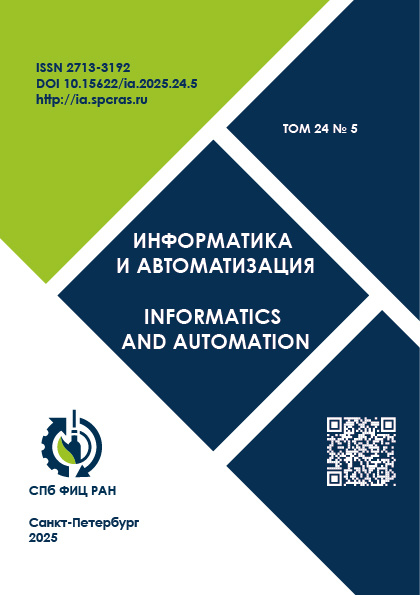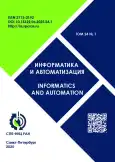ADA-NAF: Полуконтролируемое обнаружение аномалий на основе нейронного леса внимания
- Авторы: Агеев А.Ю1, Константинов А.В1, Уткин Л.В1
-
Учреждения:
- Санкт-Петербургский политехнический университет Петра Великого (СПбПУ)
- Выпуск: Том 24, № 1 (2025)
- Страницы: 329-357
- Раздел: Искусственный интеллект, инженерия данных и знаний
- URL: https://journal-vniispk.ru/2713-3192/article/view/278231
- DOI: https://doi.org/10.15622/ia.24.1.12
- ID: 278231
Цитировать
Полный текст
Аннотация
В этом исследовании мы представляем новую модель под названием ADA-NAF (автоэнкодер обнаружения аномалий с нейронным лесом внимания) для полуконтролируемого обнаружения аномалий, которая уникальным образом интегрирует архитектуру нейронного леса внимания (NAF), которая была разработана для объединения случайного классификатора леса с нейронной сетью, вычисляющей веса внимания для агрегации прогнозов дерева решений. Ключевая идея ADA-NAF заключается в включении NAF в структуру автоэнкодера, где он реализует функции компрессора, а также реконструктора входных векторов. Наш подход представляет несколько технических достижений. Во-первых, предлагаемая сквозная методология обучения по обычным данным, которая минимизирует ошибки реконструкции при обучении и оптимизации нейронных весов внимания для фокусировки на скрытых признаках. Во-вторых, новый механизм кодирования, который использует иерархическую структуру NAF для захвата сложных шаблонов данных. В-третьих, адаптивная структура оценки аномалий, которая объединяет ошибки реконструкции с важностью признаков на основе внимания. Благодаря обширным экспериментам с различными наборами данных ADA-NAF демонстрирует превосходную производительность по сравнению с современными методами. Модель демонстрирует особую силу в обработке многомерных данных и выявлении тонких аномалий, которые традиционные методы часто не обнаруживают. Наши результаты подтверждают эффективность и универсальность ADA-NAF как надежного решения для реальных задач обнаружения аномалий с перспективными приложениями в кибербезопасности, промышленном мониторинге и диагностике здравоохранения. Эта работа продвигает эту область, представляя новую архитектуру, которая сочетает в себе интерпретируемость механизмов внимания с мощными возможностями обучения признакам автоэнкодеров.
Ключевые слова
Об авторах
А. Ю Агеев
Санкт-Петербургский политехнический университет Петра Великого (СПбПУ)
Автор, ответственный за переписку.
Email: andreyageev1@mail.ru
улица Политехническая 29
А. В Константинов
Санкт-Петербургский политехнический университет Петра Великого (СПбПУ)
Email: andrue.konst@gmail.com
улица Политехническая 29
Л. В Уткин
Санкт-Петербургский политехнический университет Петра Великого (СПбПУ)
Email: lev.utkin@gmail.com
улица Политехническая 29
Список литературы
- Chandola V., Banerjee A., Kumar V. Anomaly detection: A survey. ACM Computing Surveys. 2009. vol. 41. no. 3. pp. 1–58. doi: 10.1145/1541880.1541882.
- Barnett V., Lewis T. Outliers in statistical data. 3rd Edition. New York: Wiley, 1994. 608 p.
- Grubbs F.E. Procedures for detecting outlying observations in samples. Technometrics. 1969. vol. 11. pp. 1–21. doi: 10.1080/00401706.1969.10490657.
- Goldstein M. Special Issue on Unsupervised Anomaly Detection. Applied Sciences. 2023. vol. 13(10). doi: 10.3390/app13105916.
- Zhang C., Liu J., Chen W., Shi J., Yao M., Yan X., Xu N., Chen D. [Retracted] Unsupervised Anomaly Detection Based on Deep Autoencoding and Clustering. Security and Communication Networks. 2021. vol. 2021. doi: 10.1155/2021/7389943.
- Sarvari H., Domeniconi C., Prenkaj B., Stilo G. Unsupervised boosting-based autoencoder ensembles for outlier detection. Proceedings of Pacific-Asia Conference on Knowledge Discovery and Data Mining. 2021. pp. 91–103. doi: 10.1007/978-3-030-75762-5_8.
- Yoshihara K., Takahashi K. A simple method for unsupervised anomaly detection: An application to Web time series data. Plos one. 2022. vol. 17. no. 1. doi: 10.1371/journal.pone.0262463.
- Kiran B.R., Thomas D.M., Parakkal R. An overview of deep learning based methods for unsupervised and semi-supervised anomaly detection in videos. Journal of Imaging. 2018. vol. 4. no. 2. doi: 10.3390/jimaging4020036.
- Al-amri R., Murugesan R.K., Man M., Abdulateef A.F., Al-Sharafi M.A., Alkahtani A.A. A review of machine learning and deep learning techniques for anomaly detection in IoT data. Applied Sciences. 2021. vol. 11. no. 12. doi: 10.3390/app11125320.
- Finke T., Kramer M., Morandini A., Muck A., Oleksiyuk I. Autoencoders for unsupervised anomaly detection in high energy physics. Journal of High Energy Physics. 2021. vol. 2021. no. 6. doi: 10.1007/JHEP06(2021)161.
- Konstantinov A.V., Utkin L.V., Lukashin A.A., Muliukha V.A. Neural attention forests: Transformer-based forest improvement. Proceedings of International Conference on Intelligent Information Technologies for Industry. 2023. pp. 158–167.
- Liu F.T., Kai M.T., Zhou Z.H. Isolation forest. Proceedings of 8th IEEE International Conference on Data Mining. 2008. pp. 413–422. doi: 10.1109/ICDM.2008.17.
- Xu H., Pang G., Wang Y., Wang Y. Deep Isolation Forest for Anomaly Detection. IEEE Transactions on Knowledge and Data Engineering. 2023. vol. 35. no. 12. pp. 12591–12604. doi: 10.1109/TKDE.2023.3270293.
- Ahmed M., Mahmood A.N., Hu J. A survey of network anomaly detection techniques. Journal of Network and Computer Applications. 2016. vol. 60. pp. 19–31. doi: 10.1016/j.jnca.2015.11.016.
- Liao Y., Bartler A., Yang B. Anomaly detection based on selection and weighting in latent space. Proceedings of 2021 IEEE 17th International Conference on Automation Science and Engineering (CASE). 2021. pp. 409–415. doi: 10.1109/CASE49439.2021.9551267.
- Xu J., Wu H., Wang J., Long M. Anomaly Transformer: Time Series Anomaly Detection with Association Discrepancy. Proceedings of Tenth International Conference on Learning Representations. 2022.
- Hojjati H., Ho T.K.K., Armanfard N. Self-supervised anomaly detection: A survey and outlook. arXiv preprint arXiv:2205.05173. 2022.
- Perera P., Oza P., Patel V.M. One-class classification: A survey. arXiv preprint arXiv:2101.03064. 2021.
- Darban Z.Z., Webb G.I., Pan S., Aggarwal C.C., Salehi M. Deep learning for time series anomaly detection: A survey. ACM Computing Surveys. 2024. vol. 57. no. 1. doi: 10.1145/369133.
- Chalapathy R., Chawla S. Deep learning for anomaly detection: A survey. arXiv preprint arXiv:1901.03407. 2019.
- Landauer M., Onder S., Skopik F., Wurzenberger M. Deep learning for anomaly detection in log data: A survey. Machine Learning with Applications. 2023. vol. 12. doi: 10.1016/j.mlwa.2023.100470.
- Di Mattia F., Galeone P., De Simoni M., Ghelfi E. A survey on gans for anomaly detection. arXiv preprint arXiv:1906.11632. 2019.
- Suarez J.J.P., Naval Jr P.C. A survey on deep learning techniques for video anomaly detection. arXiv preprint arXiv:2009.14146. 2020.
- Tschuchnig M.E., Gadermayr M. Anomaly detection in medical imaging-a mini review. Proceedings of the 4th International Data Science Conference–iDSC 2021. 2022. pp. 33–38.
- Niu Z., Zhong G., Yu H. A review on the attention mechanism of deep learning. Neurocomputing. 2021. vol. 452. pp. 48–62. doi: 10.1016/j.neucom.2021.03.091.
- Bahdanau D., Cho K., Bengio Y. Neural machine translation by jointly learning to align and translate. arXiv preprint arXiv:1409.0473. 2014.
- Zhu Y., Newsam S. Motion-aware feature for improved video anomaly detection. arXiv preprint arXiv:1907.10211. 2019.
- Hashimoto M., Ide Y., Aritsugi M. Anomaly detection for sensor data of semiconductor manufacturing equipment using a GAN. Procedia Computer Science. 2021. vol. 192. pp. 873–882. doi: 10.1016/j.procs.2021.08.090.
- Wu X., Huang S., Li M., Deng Y. Vector magnetic anomaly detection via an attention mechanism deep-learning model. Applied Sciences. 2021. vol. 11. no. 23. doi: 10.3390/app112311533.
- Yu Y., Zha Z., Jin B., Wu G., Dong C. Graph-Based Anomaly Detection via Attention Mechanism. Proceedings of on: 18th International Conference on Intelligent Computing Theories and Application. 2022. pp. 401–411. doi: 10.1007/978-3-031-13870-6_33.
- Tang T.W., Hsu H., Huang W.R., Li K.M. Industrial Anomaly Detection with Skip Autoencoder and Deep Feature Extractor. Sensors. 2022. vol. 22. no. 23. doi: 10.3390/s22239327.
- Utkin L.V., Konstantinov A.V. Attention-based random forest and contamination model. Neural Networks: the official journal of the International Neural Network Society. 2022. vol. 154. pp. 346–359.
- Utkin L., Ageev A., Konstantinov A., Muliukha V. Improved Anomaly Detection by Using the Attention-Based Isolation Forest. Algorithms. 2023. vol. 16. no. 1. doi: 10.3390/a16010019.
- Cai Z. Weighted nadaraya–watson regression estimation. Statistics and probability letters. 2001. vol. 51. no. 3. pp. 307–318. doi: 10.1016/S0167-7152(00)00172-3.
- Rumelhart D.E., Hinton G.E., Williams R.J. Learning internal representations by error propagation. Parallel Distributed Processing: Explorations in the Microstructure of Cognition. 1986. vol. 1. pp. 318–362.
- Hawkins S., He H., Williams G., Baxter R. Outlier detection using replicator neural networks. International Conference on Data Warehousing and Knowledge Discovery. 2002. pp. 170–180. doi: 10.1007/3-540-46145-0_17.
- Vaswani A., Shazeer N., Parmar N., Uszkoreit J., Jones L., Gomez A.N., Kaiser L., Polosukhin I. Attention is all you need. Advances in neural information processing systems. 2017. vol. 30.
- Arrhythmia Dataset. Available at: https://www.kaggle.com/code/mtavares51/binary-classification-on-arrhythmia-dataset. (accessed 30.05.2024).
- Credit Card Fraud Detection Dataset. Available at: https://www.kaggle.com/code/shivamsekra/credit-card-fraud-detection-eda-isolation-forest. (accessed 30.05.2024).
- Pima Indians Diabetes Dataset. Available at: https://www.kaggle.com/code/hafizramadan/data-science-project-iii. (accessed 30.05.2024).
- Haberman’s Survival Dataset. Available at: https://www.kaggle.com/datasets/gilsousa/habermans-survival-data-set. (accessed 30.05.2024).
- Ionosphere Dataset. Available at: https://www.kaggle.com/code/zymzym/classification-of-the-ionosphere-dataset-by-knn. (accessed 30.05.2024).
- Seismic Bumps Dataset. Available at: https://www.kaggle.com/datasets/pranabroy94/seismic-bumps-data-set. (accessed 30.05.2024).
- Shuttle Dataset. Available at: https://github.com/xuhongzuo/deep-iforest/tree/main. (accessed 30.05.2024).
- Annthyroid Dataset. Available at: https://github.com/GuansongPang/deviation-network. (accessed 30.05.2024).
- Bank Additional Dataset. Available at: https://github.com/GuansongPang/deviation-network. (accessed 30.05.2024).
- CelebA Dataset. Available at: https://github.com/GuansongPang/deviation-network. (accessed 30.05.2024).
Дополнительные файлы










